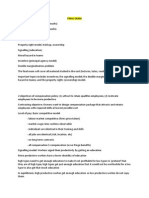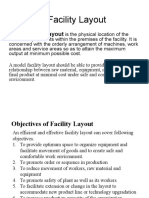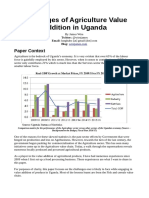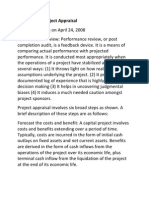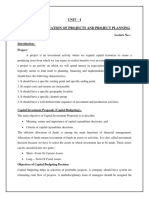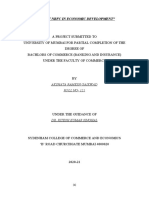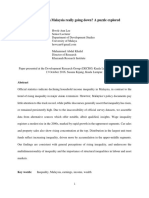Project Appraisal
Uploaded by
nailwalnamitaProject Appraisal
Uploaded by
nailwalnamitaProject appraisal
From Wikipedia, the free encyclopedia
Jump to: navigation, search
Project appraisal is a generic term that refers to the process of assessing, in a structured
way, the case for proceeding with a project or proposal. In short, project appraisal is the
effort of calculating a project's viability[1]. It often involves comparing various options,
using economic appraisal or some other decision analysis technique[2][3].
[edit] Process
• Initial Assessment
• Define problem and long-list
• Consult and short-list
• Develop options
• Compare and select Project
[edit] Types of appraisal
• Financial
o Cost-benefit analysis[4][5][6]
• Economic appraisal[7]
o Cost-effectiveness analysis
o Scoring and weighting
project appraisal
Definition
Systematic and comprehensive review of the economic, environmental, financial, social, technical and
other such aspects of a project to determine if it will meet its objectives.
Key Steps in Project Appraisal
by V S Rama Rao on April 24, 2008
in Finance Management
Performance Review: Performance review, or post completion audit, is a feedback
device. It is a means of comparing actual performance with projected performance. It is
conducted most appropriately when the operations of a project have stabilized and is
useful in several ways: (1) It throws light on how realistic were the assumptions
underlying the project. (2) It provides a documented log of experience that is highly
valuable for decision making (3) It helps in uncovering judgmental biases (4) It induces a
much needed caution amongst project sponsors.
Project appraisal involves six broad steps as shown. A brief description of these steps are
as follows:
Forecast the costs and benefit: A capital project involves costs and benefits extending
over a period of time. Typically, costs are incurred in the form of initial cash outlays on
fixed assets and net current assets. Benefits are derived in the form of cash inflows from
the operations of the project over its economic life, plus terminal cash inflow from the
liquidation of the project at the end of its economic life.
Apply suitable investment criteria: The stream of costs and benefits of the project has to
be converted into a measure indicating how worth while is the Project. For this purpose,
several investment criteria are used. They fall into two broad categories: discounted cash
flow criteria and non-discounted cash flow criteria.
Keys Steps in project Appraisal
Forecast costs and benefits
Select appraisal criteria
Assess risk
Estimate the cost of capital
Value the options
Consider the overall corporate perspective
While the former calls for discounting the future benefits using an appropriate discount
rate, the latter does not involve any discounting.
Assess the risk of the project: Costs and benefits associated with a capital project are
almost invariably subject to risk. There may be a lot of variability characterizing factors
like project cost, sales quantity, selling price, material cost, energy cost, project life, and
salvage value. The actual values of these variables often turn out to be different from
their forecast values. Hence, you should try to get a handle over how the variability in
these factors can affect the attractiveness of the project.
Estimate the cost of capital: The cost of capital is the discount rate used for evaluating a
capital project. Under appropriate conditions, it is measured as the weighted average cost
of different sources of capital employed for financing the project. The cost of a specific
source of finance is defined as the rate of discount that equates the present value of the
expected post tax payments to that source of finance, with the net funds received from
that source.
Value the options: The traditional approach to project appraisal calls for judging a project
on the basis of its net present value, obtained by discounting the project cash flow stream
using an appropriate cost of capital. This approach however, is incomplete as it fails to
capture the value of real options embedded in the project. Hence, the traditional Net
Present Value analysis needs to be expanded to include the value of real options inherent
in the project.
Consider the overall corporate perspective: Capital investments in plant, machinery,
buildings, research, facilities, product development, marketing programs, and so on are
tangible expressions of a company’s strategy. Hence, capital investment decisions must
be evaluated from the overall perspective of the firm. In such an evaluation, due
consideration should be given to general economic outlook, prospects of industries in
which the firm operates, and the competitive position and core competencies of the firm.
You might also like
- Yogurt Business Plan Sample - Tangy SpoonNo ratings yetYogurt Business Plan Sample - Tangy Spoon62 pages
- Storage and Ware Housing of Agricultural ProductsNo ratings yetStorage and Ware Housing of Agricultural Products14 pages
- Topic 2 Competitiveness, Strategy, and Productivity: ProblemsNo ratings yetTopic 2 Competitiveness, Strategy, and Productivity: Problems2 pages
- 2017040742krushi Jeevan Agro. Farmer Producer Co.No ratings yet2017040742krushi Jeevan Agro. Farmer Producer Co.12 pages
- Quantitative Techniques in Management (NEW)No ratings yetQuantitative Techniques in Management (NEW)41 pages
- Economic Order Quantity and Economic Production Quantity0% (1)Economic Order Quantity and Economic Production Quantity4 pages
- Module - 3 Feasibility Analysis and Crafting Business Plan Chetan T.RNo ratings yetModule - 3 Feasibility Analysis and Crafting Business Plan Chetan T.R56 pages
- Value Chain Governance and Gender: Saffron Production in AfghanistanNo ratings yetValue Chain Governance and Gender: Saffron Production in Afghanistan37 pages
- Chapter 9 Cash Flow Analysis To Make Investment DecisionsNo ratings yetChapter 9 Cash Flow Analysis To Make Investment Decisions6 pages
- POM Class Note 07-Facility Layout Line BalancingNo ratings yetPOM Class Note 07-Facility Layout Line Balancing55 pages
- MC0079 - Computer Based Optimization MethodsNo ratings yetMC0079 - Computer Based Optimization Methods10 pages
- 2017011818CHC - Final Project-Sudam Thakur PDFNo ratings yet2017011818CHC - Final Project-Sudam Thakur PDF32 pages
- Break-Even Analysis: (Cost-Volume-Profit Analysis)No ratings yetBreak-Even Analysis: (Cost-Volume-Profit Analysis)8 pages
- Retail Business Report On Spar PakistanNo ratings yetRetail Business Report On Spar Pakistan46 pages
- Study of Different Cropping Pattern Followed by The Farmers of PunjabNo ratings yetStudy of Different Cropping Pattern Followed by The Farmers of Punjab8 pages
- Proposal For Grant Assistance For PromotionNo ratings yetProposal For Grant Assistance For Promotion11 pages
- Adjusted Feasibility Study of Kimcs - AbujaNo ratings yetAdjusted Feasibility Study of Kimcs - Abuja54 pages
- Need of The Hour Design Field With Ndepth Knowledge of Mechanical SoftwaresNo ratings yetNeed of The Hour Design Field With Ndepth Knowledge of Mechanical Softwares3 pages
- Sunsetting: A Framework For Foundation Life As Well As DeathNo ratings yetSunsetting: A Framework For Foundation Life As Well As Death37 pages
- G. C. Harcourt - Some Cambridge Controversies in The Theory of Capital (1972) PDFNo ratings yetG. C. Harcourt - Some Cambridge Controversies in The Theory of Capital (1972) PDF283 pages
- Reading Comprehension Questions For Ibps Po PrelimsNo ratings yetReading Comprehension Questions For Ibps Po Prelims32 pages
- Tech Investors Cull Start-Ups For Pentagon - New York TimesNo ratings yetTech Investors Cull Start-Ups For Pentagon - New York Times3 pages
- Is Inequality in Malaysia Really Going Down? A Puzzle ExploredNo ratings yetIs Inequality in Malaysia Really Going Down? A Puzzle Explored40 pages
- Performance Appraisal OF EMPLOYEE AT KESORAM-1No ratings yetPerformance Appraisal OF EMPLOYEE AT KESORAM-168 pages
- Ethiopia - Proclamation On Investment (English)No ratings yetEthiopia - Proclamation On Investment (English)21 pages
- Bajaj Auto Financial Analysis: Presented byNo ratings yetBajaj Auto Financial Analysis: Presented by34 pages
- CFA Level 3 Curriculum Changes 2021 (300hours)No ratings yetCFA Level 3 Curriculum Changes 2021 (300hours)1 page


